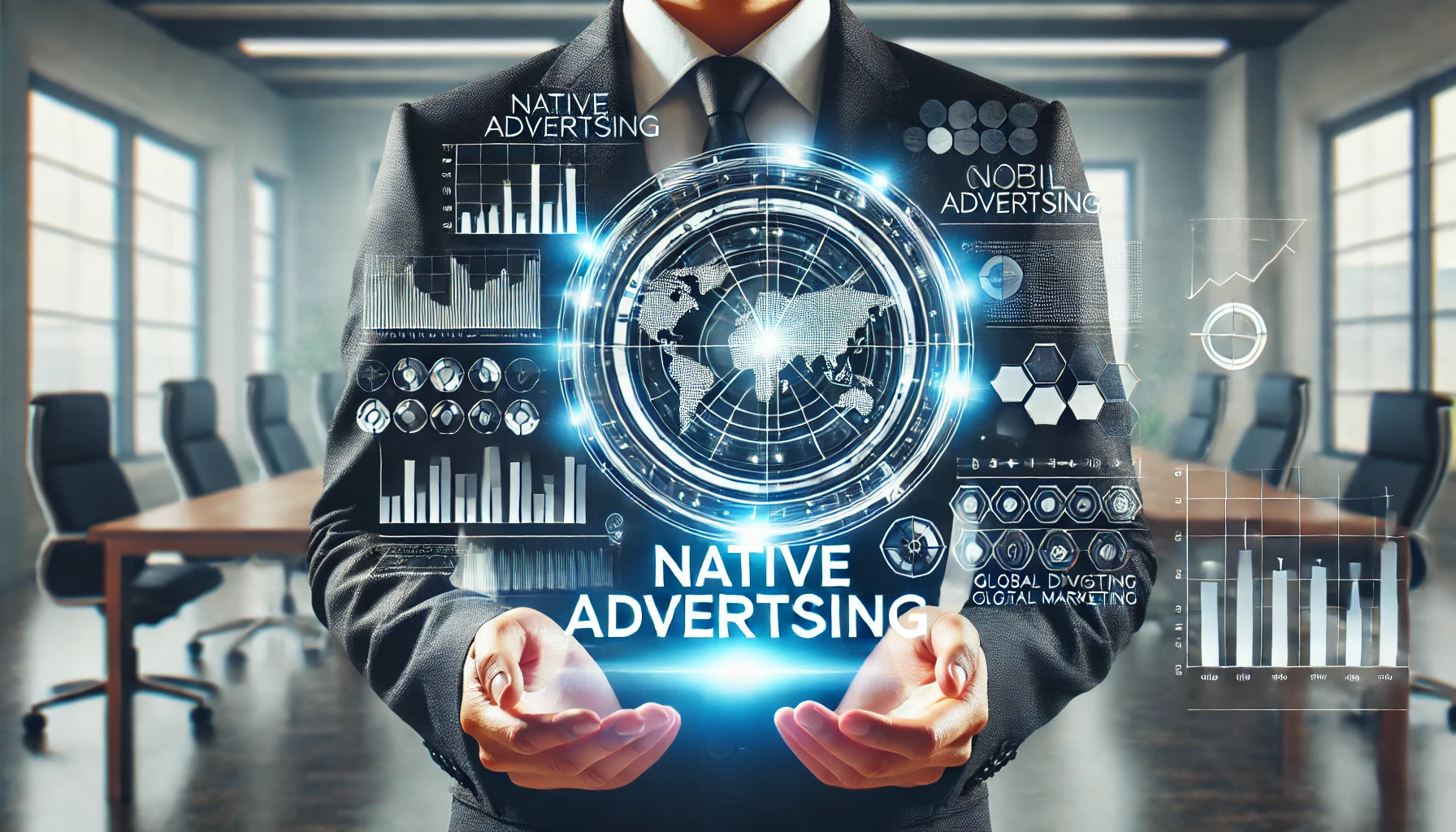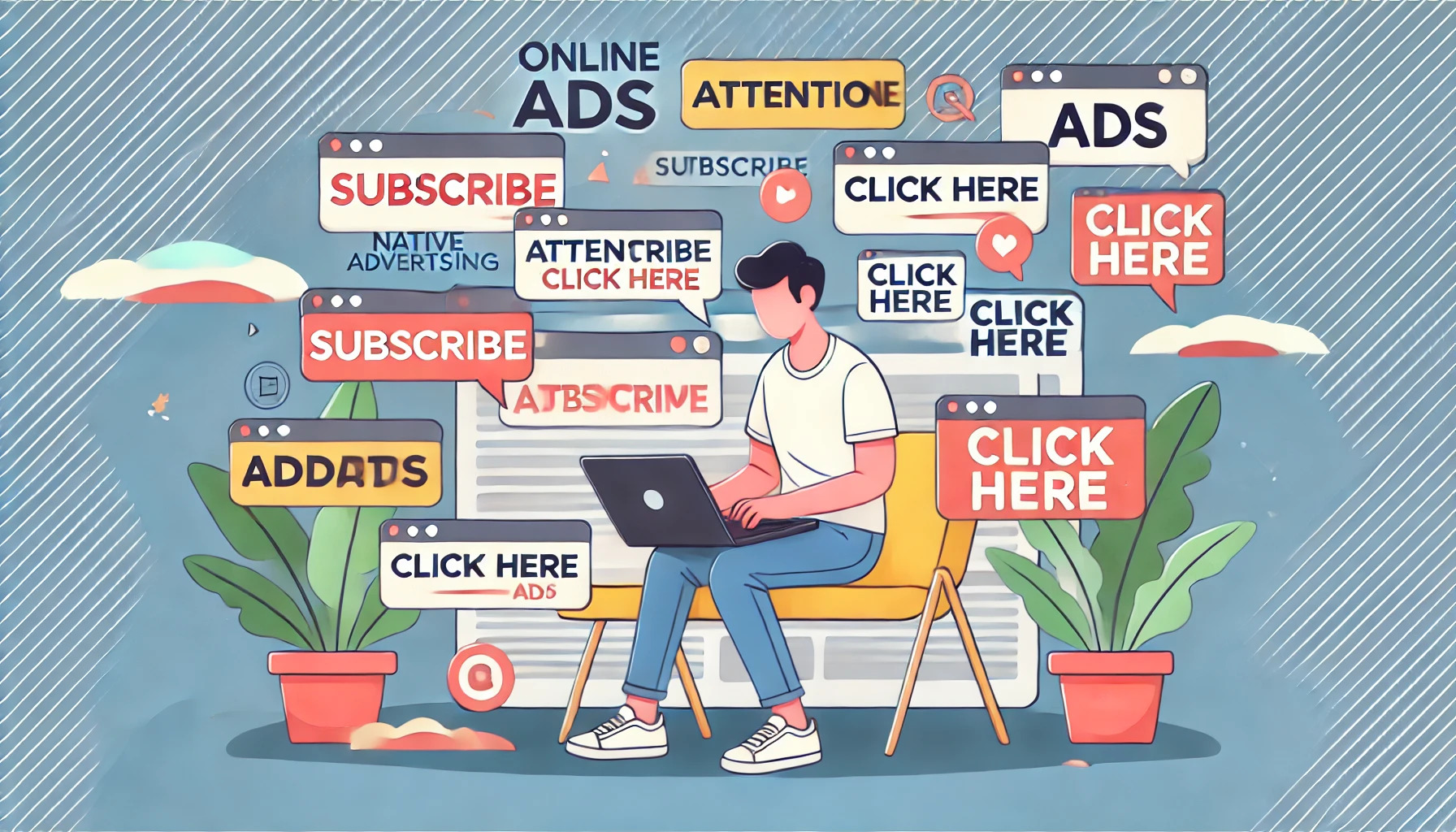Advertising is evolving in innovative and creative ways to connect more effectively with target audiences. One of the methods that has gained significant attention in the digital marketing industry is native advertising. This advertising approach allows companies to naturally integrate their content into digital environments, enhancing engagement with their audiences and ultimately achieving their marketing goals.
This article, titled “The Role of Native Advertising in Modern Digital Marketing Strategies,” has been developed by the Research and Development unit at Flexinexa.

What is meant by native advertising?
Native advertising is a type of advertisement designed to blend in with the regular content of a website, app, or media platform. The goal is for the user not to realize they’re seeing an ad, but rather to think that it’s just part of the normal content.
Simple Example:
Imagine you’re reading an article on a news website. As you’re browsing, you come across what seems like another article or analysis, but in reality, it was written by a company to subtly promote their product or service. Because this content looks and feels like the other articles on the site, you might not even realize it’s an ad. This is an example of native advertising.
This approach is effective because, by resembling regular content, users are more likely to engage with it and less likely to skip over it or ignore it.
What are the characteristics of native advertisements?
Native advertising has several key features that distinguish it from traditional advertising. These features include:
Integration with the Environment
Native advertising is designed to align with the appearance, style, and tone of the main content on the platform where it appears (such as a website, social media, or app). This alignment helps the ad blend naturally into its environment, making it less likely to be recognized as an explicit advertisement.
Value to the User
Unlike traditional ads that focus directly on selling, native advertising often provides content that is valuable to the user, such as educational, entertaining, or analytical information. This makes users more likely to engage with the advertised content.
Indirect Messaging
Unlike traditional ads that directly promote products or services, native advertising delivers its message indirectly. These ads are designed to resemble recommendations or regular content rather than being overtly promotional.
Higher User Acceptance
Because native ads resemble the main content, users generally find them less intrusive and are more likely to interact with them. These ads are less likely to be dismissed as advertisements, leading to greater engagement from users.
Seamless User Experience
Native advertising is crafted in a way that it does not disrupt the user experience. Since these ads are in harmony with the natural flow of the platform’s content, users typically interact with them without interruption or annoyance.
Precise Targeting
Native advertising is often tailored to attract specific and targeted audiences. These ads are customized based on users’ interests, behaviors, and needs, ensuring that the advertising message reaches the right people.
These features make native advertising a powerful tool in digital marketing because it not only captures users’ attention but also enhances their overall experience.

All kinds of native advertising
Native advertising can be divided into various types, each differing depending on the platform and the type of content being presented. Below are some of the most common types of native advertising:
Sponsored Articles
These are articles or posts that resemble regular content on websites but are written by a brand to promote specific products or services. These articles are typically published on news websites or blogs.
In-Feed Ads
These ads appear as posts within social media feeds or news feeds on websites. They are designed to look like regular posts in the feed and blend seamlessly into the natural flow of content.
Native Video Ads
These are short video ads presented on platforms like YouTube or social media. Native videos are usually aligned with the original video content and are designed not to disrupt the viewer’s experience.
In-App Native Ads
These ads are displayed within mobile apps and are designed to align with the app’s appearance and functionality. They may appear as small banners or in-app offers.
Recommendation Widgets
These ads appear as content suggestions at the end of articles or web pages. These recommendations might include links to other articles or related products and services sponsored by brands.
Sponsored Content
This type of content is financially supported by a brand or company and published in the form of the main content of a media platform. It can be in the form of videos, podcasts, or even infographics, designed to be consistent with the platform’s main content.
Native Ads in Search Engines
These ads appear as search results in search engines like Google and resemble organic search results but are, in fact, ads paid for by brands.
Native Email Ads
In this type of advertising, promotional content is sent in emails that resemble regular emails. These emails might include educational or news content that subtly introduces a specific product or service.
Each of these types of native advertising is designed for specific goals and audiences and can be effectively used to capture attention and increase user engagement depending on the marketing strategy.

Successful Examples of Native Advertising
Here are a few successful examples of native advertising that have managed to capture audience attention and achieve their marketing goals:
Sponsored Articles by Netflix in The New York Times
Example: To promote the series “Orange is the New Black,” Netflix published a long and detailed article in The New York Times that examined the conditions of female prisoners in the United States. This article was well-aligned with the usual content of The New York Times and provided valuable information to readers while indirectly promoting the Netflix series.
Result: This campaign was highly successful and garnered significant attention, as it naturally fit within The New York Times’ content and provided readers with valuable insights.
Coca-Cola’s Native Advertising on Instagram
Example: Coca-Cola used short images and videos on Instagram, all designed around themes of happiness and sharing joyful moments. These posts were crafted to resemble regular user posts on Instagram and appeared naturally in users’ feeds.
Result: This campaign generated high engagement and strengthened the emotional connection between users and the Coca-Cola brand.
The New York Times’ Native Advertising for Shell
Example: The oil company Shell published a long article in The New York Times that explored the future of renewable energy and its role in global sustainable development. This article was fully aligned with The New York Times’ analytical content and provided scientific and valuable information to readers while subtly positioning Shell as a leader in the energy industry.
Result: This native ad successfully attracted a large audience and effectively created a positive image of Shell in the minds of the readers.
BuzzFeed’s Native Advertising for Purina
Example: Purina, a pet food brand, collaborated with BuzzFeed to produce a video titled “Dogs vs. Cats,” which humorously compared the behaviors of dogs and cats. The video subtly promoted Purina’s products while being an entertaining and viral piece of content on the internet.
Result: The video was viewed millions of times and became one of the most successful examples of native advertising on BuzzFeed, as it naturally aligned with the type of content popular among the audience.
Airbnb’s Native Advertising on Social Media
Example: Airbnb used native advertising on Facebook and Instagram to promote its services. These ads included attractive images of real accommodations along with short stories of user experiences. These posts were designed to look like regular user posts and were seamlessly integrated with the usual content of social media platforms.
Result: These campaigns successfully attracted a large number of new users to the Airbnb platform and significantly increased brand awareness.
These examples demonstrate how native advertising can naturally and unobtrusively deliver promotional messages while achieving marketing objectives.
![]()
Advantages of Native Advertising
Increased User Engagement
Native advertising, due to its alignment with the platform’s main content, is less likely to be seen as intrusive, leading to higher user engagement.
Improved User Experience
Since native ads blend naturally with the main content, they do not disrupt the user experience.
Higher Trust from Users
Users tend to trust native ads more because they resemble regular content.
Higher Conversion Rates
The increased engagement and trust in native ads often lead to higher conversion rates.
Precise Targeting
Native ads are usually tailored to the interests and needs of the target audience, delivering the advertising message to the right people.
Increased Brand Awareness
Native advertising naturally reaches users without being intrusive, helping to increase brand awareness.
Disadvantages of Native Advertising
Less Transparency
Because native ads are subtly integrated with the main content, users might not realize they are viewing an advertisement, which can raise ethical concerns.
Higher Costs
Creating high-quality, well-integrated native ads can be expensive, especially when custom and creative content is required.
Limited Creativity
The need to align with the main content may impose limitations on creativity and innovation in designing native ads.
Harder to Measure Performance
Accurately assessing the impact of native advertising can be challenging, as traditional performance metrics may not fully capture its effectiveness.
Time-Consuming
Developing and executing native advertising campaigns may take more time compared to traditional ads.
Native advertising has emerged as a powerful tool in modern digital marketing strategies, earning a significant place due to its seamless integration with platform content. This approach not only enhances user engagement but also improves user experience and builds trust, leading to stronger branding and higher conversion rates.
When combined with content marketing and search engine optimization (SEO), native advertising serves as a potent method for precise audience targeting and achieving desired outcomes in online advertising campaigns. By aligning directly with users’ needs and interests, it not only increases the effectiveness of advertising strategies but also plays a crucial role in boosting brand awareness and enhancing user engagement.
Given these advantages, incorporating native advertising into digital marketing strategies is essential. However, it’s important to recognize that optimal use of this method requires careful planning, high-quality content creation, and continuous performance measurement. Ultimately, native advertising can be an effective solution for increasing user engagement, elevating brand presence, and achieving marketing goals.
____________________
FAQ
- What is Native Advertising and how does it differ from traditional advertising?
Answer:
Native advertising is a form of paid media where the ad experience follows the natural form and function of the user experience in which it is placed. Unlike traditional advertising, which is often disruptive, native ads blend seamlessly with the surrounding content, making them less intrusive and more engaging for users.
- How can Native Advertising improve my Digital Marketing strategy?
Answer:
Native advertising can enhance your digital marketing strategy by providing a more engaging and non-intrusive way to reach your target audience. By aligning the ad content with the platform’s editorial style, native ads can boost user engagement, improve conversion rates, and support overall branding efforts.
- Can Native Advertising help with SEO?
Answer:
Yes, native advertising can indirectly support SEO efforts. High-quality native content that engages users can increase time spent on your site and reduce bounce rates, both of which are positive signals for search engine rankings. Additionally, if native ads lead to more backlinks, they can directly improve your site’s SEO.
- How does Native Advertising fit into Content Marketing?
Answer:
Native advertising is a natural extension of content marketing. It allows brands to create valuable, relevant content that fits seamlessly within a platform, thereby enhancing the user experience. This approach can drive better user engagement and more meaningful interactions with your brand.
- What role does Native Advertising play in Branding?
Answer:
Native advertising helps build and reinforce branding by presenting your message in a way that aligns with the content users are already engaging with. By providing value and being less intrusive, native ads can foster a positive brand association and increase brand awareness.
- How does Native Advertising affect User Engagement?
Answer:
Because native ads are designed to blend in with the content surrounding them, they often result in higher user engagement compared to traditional ads. Users are more likely to interact with content that feels relevant and non-disruptive, leading to improved interaction rates.
- Is Native Advertising effective for Audience Targeting?
Answer:
Absolutely. Native advertising can be highly effective for audience targeting because it can be tailored to the interests and behaviors of specific user segments. By delivering relevant content to the right audience, native ads can increase the likelihood of user interaction and conversions.
- What impact does Native Advertising have on Conversion Rates?
Answer:
Native advertising often leads to higher conversion rates due to its non-intrusive nature and relevance to the user. By providing a seamless and engaging experience, users are more likely to take the desired action, whether it’s making a purchase, signing up for a service, or another conversion goal.
- How does Native Advertising integrate with Online Advertising strategies?
Answer:
Native advertising complements online advertising strategies by offering a less intrusive and more user-friendly approach to promoting products or services. It can be used alongside display ads, search ads, and social media campaigns to create a well-rounded digital marketing strategy.
- What are the best practices for implementing Native Advertising?
Answer:
To implement native advertising effectively, focus on creating high-quality content that aligns with the platform’s style and provides value to the audience. Ensure that your ads are targeted to the right audience, and use analytics to track performance and make data-driven adjustments to your strategy.















